
Concept explainers
(a)
Particle’s velocity at time
(a)
Answer to Problem 58E
The velocity at
Explanation of Solution
Given information:
Position at time t (sec) of a particle moving along a coordinate axis:
Where,
f is the differentiable function
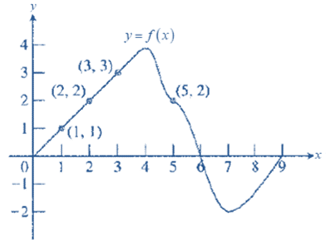
The velocity of s is s’.
Since
Then
According to FTC (Fundamental Theorem of Calculus),
The velocity at
From the graph,
Thus,
The velocity at
(b)
Whether the acceleration of particle at time
(b)
Answer to Problem 58E
The acceleration of particle is negative at
Explanation of Solution
Given information:
Position at time t (sec) of a particle moving along a coordinate axis:
Where,
f is the differentiable function
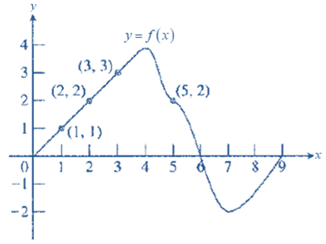
The acceleration of s is s”.
Since
Then
According to FTC (Fundamental Theorem of Calculus),
Second derivative:
That means
From the graph,
The slope of f at 5 is negative.
Thus,
Therefore,
The acceleration of particle is negative at
(c)
Particle’s position at time
(c)
Answer to Problem 58E
Particle’s position at 3 seconds is 4.5.
Explanation of Solution
Given information:
Position at time t (sec) of a particle moving along a coordinate axis:
Where,
f is the differentiable function
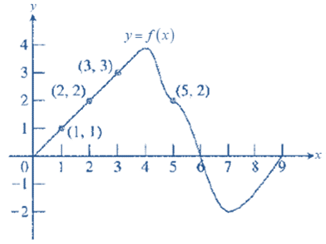
The region between
Then
The position at 3 seconds:
Therefore,
Particle’s position at 3 seconds is 4.5.
(d)
Time during the first 9 sec for s have its largest value.
(d)
Answer to Problem 58E
The largest value for s occurs at
Explanation of Solution
Given information:
Position at time t (sec) of a particle moving along a coordinate axis:
Where,
f is the differentiable function
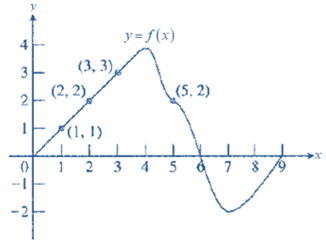
s will have the largest value when it reaches the absolute maximum.
In order to know where the maximum occurs,
We are required to find at what value of t the first derivative of s switches from being positive to negative.
Since
Then
According to FTC (Fundamental Theorem of Calculus),
From the graph,
f is positive for 0 to 6 and negative for 6 to 9.
Therefore,
For
s must be larger at
Since
Then
Since
Then
Thus,
s is larger at
Therefore,
The largest value for s occurs at
(e)
Approximate the zero value of acceleration.
(e)
Answer to Problem 58E
The acceleration is zero when
Explanation of Solution
Given information:
Position at time t (sec) of a particle moving along a coordinate axis:
Where,
f is the differentiable function
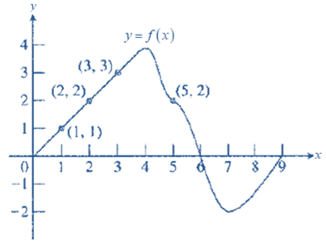
Since
At
We have
Also,
At
We have
Therefore,
Acceleration is zero at both 4 seconds and 7 seconds.
(f)
Movement of the particle towards and away from the origin.
(f)
Answer to Problem 58E
The particle moves away from the origin in the positive direction on the interval [0, 6].
The particle moves towards the origin in the negative direction on the interval [6, 9].
Explanation of Solution
Given information:
Position at time t (sec) of a particle moving along a coordinate axis:
Where,
f is the differentiable function
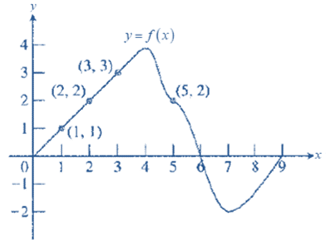
Note that
Such that
The particle is at origin at
On the interval [0, 6]:
We have
Thus,
The particle moves away from the origin in the positive direction.
On the interval [6, 9]:
We have
Also,
The area below the x-axis is smaller above the x-axis.
Thus,
The particle moves towards the origin in negative direction.
(g)
Side of the origin for the particle at time
(g)
Answer to Problem 58E
The particle lies on positive side of the origin at time
Explanation of Solution
Given information:
Position at time t (sec) of a particle moving along a coordinate axis:
Where,
f is the differentiable function
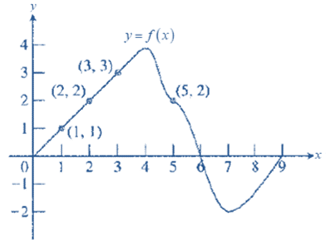
Since the particle starts at the origin,
Then
Also,
The area below the x-axis between
Thus,
Therefore,
The particle lies on the positive side of the origin at 9 seconds.
Chapter 6 Solutions
Calculus 2012 Student Edition (by Finney/Demana/Waits/Kennedy)
Additional Math Textbook Solutions
Elementary Statistics (13th Edition)
Algebra and Trigonometry (6th Edition)
A Problem Solving Approach To Mathematics For Elementary School Teachers (13th Edition)
A First Course in Probability (10th Edition)
Elementary Statistics: Picturing the World (7th Edition)
Basic Business Statistics, Student Value Edition
- For each of the following series, determine whether the absolute convergence series test determines absolute convergence or fails. For the ¿th series, if the test is inconclusive then let Mi = 4, while if the test determines absolute convergence let Mi 1 : 2: ∞ Σ(−1)"+¹ sin(2n); n=1 Σ n=1 Σ ((−1)”. COS n² 3+2n4 3: (+ 4: 5 : n=1 ∞ n 2+5n3 ПП n² 2 5+2n3 пп n² Σ(+)+ n=1 ∞ n=1 COS 4 2 3+8n3 П ηπ n- (−1)+1 sin (+727) 5 + 2m³ 4 = 8. Then the value of cos(M₁) + cos(2M2) + cos(3M3) + sin(2M) + sin(M5) is -0.027 -0.621 -1.794 -1.132 -1.498 -4.355 -2.000 2.716arrow_forwardi need help with this question i tried by myself and so i am uploadding the question to be quided with step by step solution and please do not use chat gpt i am trying to learn thank you.arrow_forwardi need help with this question i tried by myself and so i am uploadding the question to be quided with step by step solution and please do not use chat gpt i am trying to learn thank you.arrow_forward
- 1. 3 2 fx=14x²-15x²-9x- 2arrow_forwardNo it is not a graded assignment, its a review question but i only have the final answer not the working or explanationarrow_forwardClass, the class silues, and the class notes, whether the series does alternate and the absolute values of the terms decrease), and if the test does apply, determine whether the series converges or diverges. For the ith series, if the test does not apply the let Mi = 2, while if the test determines divergence then M¿ = 4, and if it determines convergence then M¿ = 8. 1: 2: 3 : 4: 5 : ∞ n=1 ∞ (−1)n+1. Σ(-1) +1 n=1 ∞ п 3m² +2 Σ(-1)+1 sin(2n). n=1 ∞ 2n² + 2n +3 4n2 +6 1 e-n + n² 3n23n+1 9n² +3 In(n + 1) 2n+1 Σ(-1) +1 n=1 ∞ Σ(-1)". n=1 Then the value of cos(M₁) + cos(2M2) + cos(3M3) + sin(2M4) + sin(M5) is 1.715 0.902 0.930 -1.647 -0.057 ● 2.013 1.141 4.274arrow_forward
- 3. FCX14) = x²+3xx-y3 +.arrow_forwardA cylindrical chemical storage tank with a capacity of 950m3 is going to be constructed in a warehouse that is 11m by 14m with a height of 10m. The specifications call for the case to be made of sheet metal that costs $90/m2, the top to be made from sheet metal that costs $45/m2 and the wall to be made of sheet metal that costs $80/m2. If you want to minimize the cost to make the storage house, how much would you end up spending to build the tank?arrow_forwardCalculate the max value of the directional derivatearrow_forward
 Calculus: Early TranscendentalsCalculusISBN:9781285741550Author:James StewartPublisher:Cengage Learning
Calculus: Early TranscendentalsCalculusISBN:9781285741550Author:James StewartPublisher:Cengage Learning Thomas' Calculus (14th Edition)CalculusISBN:9780134438986Author:Joel R. Hass, Christopher E. Heil, Maurice D. WeirPublisher:PEARSON
Thomas' Calculus (14th Edition)CalculusISBN:9780134438986Author:Joel R. Hass, Christopher E. Heil, Maurice D. WeirPublisher:PEARSON Calculus: Early Transcendentals (3rd Edition)CalculusISBN:9780134763644Author:William L. Briggs, Lyle Cochran, Bernard Gillett, Eric SchulzPublisher:PEARSON
Calculus: Early Transcendentals (3rd Edition)CalculusISBN:9780134763644Author:William L. Briggs, Lyle Cochran, Bernard Gillett, Eric SchulzPublisher:PEARSON Calculus: Early TranscendentalsCalculusISBN:9781319050740Author:Jon Rogawski, Colin Adams, Robert FranzosaPublisher:W. H. Freeman
Calculus: Early TranscendentalsCalculusISBN:9781319050740Author:Jon Rogawski, Colin Adams, Robert FranzosaPublisher:W. H. Freeman
 Calculus: Early Transcendental FunctionsCalculusISBN:9781337552516Author:Ron Larson, Bruce H. EdwardsPublisher:Cengage Learning
Calculus: Early Transcendental FunctionsCalculusISBN:9781337552516Author:Ron Larson, Bruce H. EdwardsPublisher:Cengage Learning





